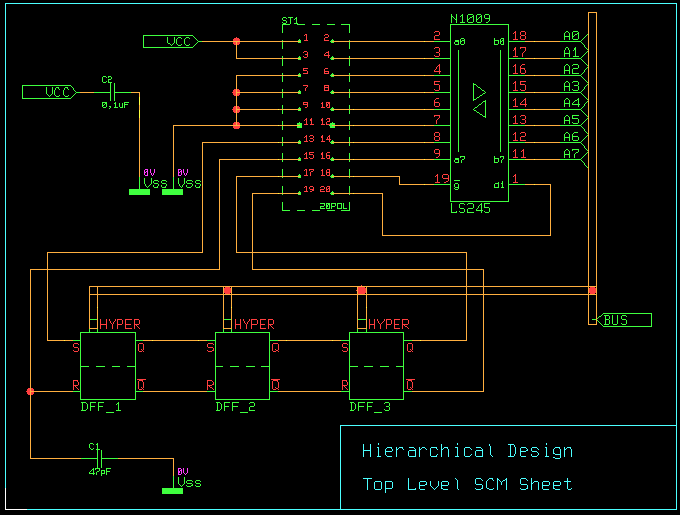The process of circuit design can cover systems ranging from national power grids all the way down to the individual transistors within an integrated circuit.
circuit design" often refers to the step of the design cycle which outputs the schematics of the integrated circuit. Typically this is the step between logic design and physical design.
For simple circuits the design process can often be done by one person without needing a planed or structured design process, but for more complex designs, teams of designers following a systematic approach with intelligently guided computer simulation are becoming increasingly common.
As circuit design is the process of working out the physical form that an electronic circuit will take, the result of the circuit design process is the instructions on how to construct the physical electronic circuit.
This will normally take the form of blueprints describing the size, shape, connectors, etc in use, and artwork or CAM file for manufacturing a printed circuit board or Integrated circuit.
- sometimes, writing the requirement specification after liaising with the customer
- writing a technical proposal to meet the requirements of the customer specification
- synthesising on paper a schematic circuit diagram, an abstract electrical or electronic circuit that will meet the specifications
- calculating the component values to meet the operating specifications under specified conditions
- performing simulations to verify the correctness of the design
- building a breadboard or other prototype version of the design and testing against specification
- making any alterations to the circuit to achieve compliance
- choosing a method of construction as well as all the parts and materials to be used
- presenting component and layout information to draughtspersons, and layout and mechanical engineers, for prototype production
- testing or type-testing a number of prototypes to ensure compliance with customer requirements
- signing and approving the final manufacturing drawings
- post-design services (obsolescence of components etc.)
The design process involves moving from the specification at the start, to a plan that contains all the information needed to be physically constructed at the end, this normally happens by passing through a number of stages, although in very simple circuit it may be done in a single step.The process normally begins with the conversion of the specification into a block diagram of the various functions that the circuit must perform, at this stage the contents of each block are not considered, only what each block must do, this is sometimes referred to as a "black box" design. This approach allows the possibly very complicated task to be broken into smaller tasks which may either by tackled in sequence or divided amongst members of a design team.
Each block is then considered in more detail, still at an abstract stage, but with a lot more focus on the details of the electrical functions to be provided. At this or later stages it is common to require a large amount of research or mathematical modeling into what is and is not feasible to achieve.The results of this research may be fed back into earlier stages of the design process, for example if it turns out one of the blocks cannot be designed within the parameters set for it, it may be necessary to alter other blocks instead. At this point it is also common to start considering both how to demonstrate that the design does meet the specifications, and how it is to be tested ( which can includeself diagnostic tools ).
Finally the individual circuit components are chosen to carry out each function in the overall design, at this stage the physical layout and electrical connections of each component are also decided, this layout commonly taking the form of artwork for the production of a printed circuit board or Integrated circuit. This stage is typically extremely time consuming because of the vast array of choices available. A practical constraint on the design at this stage is that of standardization, while a certain value of component may be calculated for use in some location in a circuit, if that value cannot be purchased from a supplier, then the problem has still not been solved. To avoid this a certain amount of 'catalog engineering' can be applied to solve the more mundane tasks within an overall design.
Once a circuit has been designed, it must be both verified and tested. Verification is the process of going through each stage of a design and ensuring that it will do what the specification requires it to do. This is frequently a highly mathematical process and can involve large-scale computer simulations of the design. In any complicated design it is very likely that problems will be found at this stage and may involve a large amount of the design work be redone in order to fix them.
Testing is the real-world counterpart to verification, testing involves physically building at least a prototype of the design and then (in combination with the test procedures in the specification or added to it) checking the circuit really does do what it was designed to.

No comments:
Post a Comment